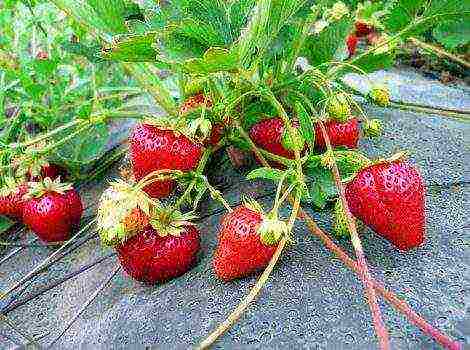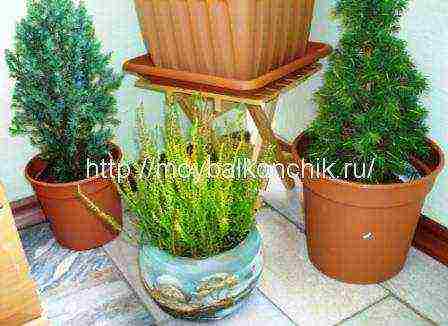Content
- 1 Features of indoor tomatoes
- 2 The best varieties of indoor tomatoes
- 3 Ampel varieties
- 4 Agricultural technology for growing indoor tomatoes
- 5 The choice of varieties for cultivation
- 6 Self-cultivation
- 7 Correct seed preparation and planting of seedlings
- 8 Caring for tomatoes during growth
- 9 Disease and pest control
- 10 Features and caveats
- 11 Seed sowing time
- 12 Preparation of planting material
- 13 Soil selection
- 14 Sowing seeds and creating conditions for seedlings
- 15 Further care for potted tomatoes
- 16 Protecting tomatoes from disease
- 17 Indoor tomato varieties
- 18 Which varieties to choose
- 19 What conditions are required for growing
- 20 Step-by-step instructions for growing a tomato
Thanks to the efforts of breeders, tomatoes can be grown on the windowsill, and at any time of the year. There are many varieties that can produce good yields indoors. Growing them is no more difficult than ordinary tomatoes in the garden, moreover, they are not afraid of either drought or the Colorado potato beetle. To enjoy fresh tomatoes in the winter cold, you need to study all the nuances of such cultivation, but the most important thing is to choose the right variety.
Tomatoes on the windowsill in winter
Features of indoor tomatoes
Indoor conditions differ significantly from those in the garden, so not every variety of tomatoes will be able to grow and bear fruit normally indoors. Varieties for growing on a windowsill have the following characteristics:
- short stature. Due to the limited space, only undersized and dwarf tomatoes are able to form a crop. Tall tomatoes require not only a lot of space, but also a large amount of nutrients, and there is too little soil in the flower pot for this;
- stamina. Not everyone knows how to form a bush correctly, but this is an important condition for the yield of a tomato. Standard varieties have a strong central stem and a dense crown; it does not need to be pinned or tied up;
- resistance to lack of lighting and disease. Indoor plants receive less light, especially in winter, and therefore really need additional lighting. But there are varieties of tomatoes that bear fruit normally in a short day, and they only need backlighting on cloudy days. Their genetic feature is short internodes, due to which the stems do not stretch. Of the diseases, tomatoes are most threatened by black leg (during the period of growing seedlings) and leaf mold. The most resistant to them are hybrids, which make up 90% of the total number of potted tomatoes.
Cherry tomatoes on the windowsill
In addition to these features, indoor tomatoes are distinguished by the highest taste qualities, and are rightfully considered the champions among tomatoes in terms of the content of vitamins and sugars in the pulp. But not all of them can boast of productivity, because some varieties are more decorative, and form very small, cherry-sized fruits. Of course, they are also edible, but there are too few of them, and therefore they are most often used to decorate dishes.
Indoor tomatoes
If you need tomatoes for daily consumption, choose large-fruit varieties that are high-yielding. As a rule, the mass of indoor tomatoes varies between 15-130 g, depending on the variety.The best of them form low bushes completely covered with fruits. On average, one bush can produce up to 2 kg of tasty, marketable tomatoes per season.
Potted tomatoes have one more feature - they are perennials. If, after collecting the last fruits, the bush is not thrown away, then after a while new leaves will appear on the stem. Usually such tomatoes grow and bear fruit within 5 years, although the most abundant harvests are given in the first 2 years.
Growing tomatoes on a windowsill
The best varieties of indoor tomatoes
The assortment of indoor tomatoes is smaller than usual, but also impressive. Varieties differ in shape, size and color of fruits, height and shape of the bush, ripening time and other parameters. Every year, new varieties and hybrids from leading breeding companies are added to their list. Below are the most popular windowsill tomatoes.
|
Balcony miracle |
This early ripe variety forms standard bushes up to half a meter high. Its fruits are red, round, with a high sugar content. Unlike most potted tomatoes, this variety grows up to 70-100 g. With good care, the yield per plant is about 2 kg. The balcony miracle adapts well to a lack of light and can bear fruit perfectly in winter |
|
Room surprise |
Early ripening, standard. The height of the bushes does not exceed half a meter, and the weight of bright red elongated fruits, collected in bunches, is equal to 25-30 g. The pulp of these tomatoes is very tasty and aromatic, they are great for salads. In winter, the plant needs lighting, otherwise the harvest will be rather weak. |
|
Bonsai |
A neat lush bush up to 30 cm high.Tomatoes of this variety have a rounded shape and rich red color, the weight of the fruit is 25 g. With good care, each plant gives 1 kg of tasty commercial tomatoes per season |
|
Micron NK |
Today it is considered the smallest type of tomato, the height of its bushes is only 12-15 cm. Round, small fruits (10-12 g) are yellow and red. You should not expect a large harvest from it, but in terms of decorativeness, the variety is ahead of most potted tomatoes. Ideal for winter growing, as it does not depend on the length of daylight hours |
|
Pinocchio |
One of the best potted varieties. Plants are not tall, maximum 30 cm, densely leafy, compact. Fruit weight - about 20 g, red color. One bush yields from 1 to 1.5 kg of tomatoes, which are suitable not only for salads, but also for canning. In the summer, it can be grown in the beds, and in the fall, the bushes are transplanted into pots and brought into the house. |
|
Pygmy |
Its fruits ripen 85-90 days after germination. Standard variety, universal use, bears fruit well in a short day. His tomatoes are small, weighing 25 g, red, fragrant. The bush itself looks very decorative during the ripening period. |
|
Florida Petite |
A popular variety appreciated for its high yield. The bushes have a compact shape, do not exceed 30 cm in height, do not need to be pinned. Its fruits are small (20-40 g), red, with very sweet pulp. The ovaries are collected in long clusters, and during the ripening of the leaves, it is almost invisible under the fruits. The variety is resistant to low light and bears fruit well in winter. |
|
Bunch of honey |
Yellow-fruited and early ripening variety. Can be grown both on the windowsill and in the open field. The height of the standard bushes does not exceed 40 cm, the crown is dense, does not need to be formed. Tomatoes weigh about 40 g, the yield is very high. The peel of the fruit is thin, orange in color, the flesh is sweet and juicy |
|
Window yellow |
A new, still rare variety. The plant is a standard plant, 25 cm tall, during the fruiting period the entire bush is covered with clusters of yellow small round tomatoes. Fruit weight rarely exceeds 30 g, the pulp is very sweet. The variety is neutral to low light, therefore it bears fruit well in winter. |
|
Teeny Tim |
Early ripening popular Dutch variety.Bears fruit regardless of the season and the degree of lighting. The height of the bushes is about 30 cm, in the open field it can grow up to 50 cm.The weight of the tomatoes is 12-14 g, the color is red, the pulp is moderately sweet |
Ampel varieties
In addition to standard varieties, ampel tomatoes are also in demand among fans of indoor tomato cultivation. They can be planted in hanging pots or in tall pots, from which the shoots will hang beautifully on the windowsill. Caring for them is a little more difficult than for ordinary varieties, and the yield is lower, but all this is offset by the excellent taste of tomatoes and the high decorative effect of the bush. The choice of ampel varieties is still small, and seeds can be purchased only from a few domestic agricultural firms.
|
Garden Pearl |
A spreading bush with shoots up to 50 cm. The plant's stems are thin, but strong, and do not break under the weight of numerous fruits. You do not need to walk the bush. Round tomatoes weighing 15-20 g, when ripe, acquire a raspberry color and become translucent. One plant can have up to three hundred fruits of a presentation. The variety is very decorative, feels great indoors and outdoors |
|
F1 Citizen |
Spectacular early maturing hybrid. It can grow vertically (but then it is necessary to tie up the stems) and as an ampelous plant. His tomatoes are round, red, with a characteristic tomato flavor, weighing about 30 g. The hybrid is specially bred for indoor cultivation, therefore it develops well and bears fruit regardless of the season |
|
Cherry Fingers F1 |
New yielding hybrid for ampel cultivation. Low-leafed shoots, up to half a meter long, strong. Small red fruits have an elongated shape, are attached to long clusters of 8-10 pieces. Tomatoes are suitable for harvesting for the winter; they do not crack during heat treatment. In good conditions, the yield of one bush is 1.8-2 kg |
|
Toggle switch |
One of the new ampelous varieties. Very early, has a cascading bush shape, the mass of tomatoes is 25-30 g. The taste of the fruits is excellent, the average yield is about 2 kg. With a lack of lighting, the number of fruits is slightly less |
|
Mascot |
Already a fairly well-known ampelous variety of domestic selection. Refers to medium early, the bush is quite compact, shoots up to 55 cm long. Egg-shaped fruits of red color, average weight about 40 g. When grown in open ground, the mass of fruits is almost twice as large. The variety is distinguished by extended fruiting, and very abundant. Tomatoes are juicy, tasty, can be preserved |
|
Red Abundance F1 |
A very attractive fruitful hybrid. Shoots grow up to 60 cm, the plant does not need pinching. The brushes are densely hung with small (20g) sweet red fruits, which are suitable for canning. The bush grows quickly, so it needs a lot of space. In winter, the plant must be highlighted, otherwise the yield will decrease |
Agricultural technology for growing indoor tomatoes
As with regular varieties, indoor tomatoes are best grown through seedlings. And at this stage there are no differences, except that the timing of sowing seeds is different. On average, potted tomatoes begin to bear fruit in 90-100 days after germination, and if you want to get the first tomatoes by a certain date, take this factor into account. For example, to harvest the first crop in January, plant the seedlings at the end of September.
Two ways to test seeds for germination
Before sowing, the seeds are disinfected by soaking for 15-30 minutes in a weak solution of potassium permanganate, and then left in a damp cloth for a couple of days to hatch.
Tomato seed preparation
Sow in a common container with ordinary soil or purchased substrate to a depth of no more than 1 cm. The distance between the seeds should be within 2-3 cm so that the seedlings are not thickened.
Capacity for growing tomatoes
Tomatoes in a box
Seedlings are transplanted into separate containers as soon as 2-3 true leaves are formed in the seedlings. The size of the pots is selected depending on the variety of tomatoes: for dwarf tomatoes, a volume of 1.5-2 liters is enough, for ordinary room ones 3-4 liters, for ampelous ones - at least 5 liters. All pots must have drainage holes. It is very important to properly prepare the soil, because the development and fruiting of the bush depends on its composition.
Soil preparation
The best option is the following composition:
- 5 parts of garden soil;
- 2 pieces of sand;
- 5 parts of rotted compost;
- 1 part peat.
On a bucket of such a mixture, it is necessary to add a matchbox of urea and potassium sulfate, a handful of sifted wood ash. All this is thoroughly mixed. Now you can start planting seedlings.
Step 1... A drainage layer of fine gravel, pieces of bark, expanded clay or other material is poured onto the bottom of the pots. Fill the containers to the top with soil and make a small depression in the center.
Filling the pot with drainage and soil
Step 2. The pre-watered seedlings are carefully removed one at a time and planted in pots, deepening to the cotyledon leaves. Water gently.
Planting tomato seedlings in a pot
The soil must be saturated with moisture for the water to get to the roots.
Step 3. They put the pots on the windowsill (preferably on the south side) and regularly turn them on the other side to the light every 2 days. In the mornings and evenings, as well as in cloudy weather, plants should be supplemented with a phytolamp.
Supplementary lighting of tomatoes with phytolamp
After a week, the plants are fed with half the nitrogen fertilizer required for growth. During the flowering period, in order to increase the percentage of pollination, the stems of the plant are very lightly shaken and carried over the flowers with a feather or a soft brush. After the formation of ovaries, fertilizing with potassium fertilizer is required once every two weeks.
In varieties that need to form a bush, remove stepchildren, pinch the top of the main stem, cut off excess inflorescences to increase the size of the fruit. Tall bushes are tied to supports, which are stuck into the ground along the edge of the pot.
Tomato care
If signs of fungal infection appear, all plants are sprayed with phytosporin or another anti-fungal agent. To prolong fruiting, regularly pick ripe fruits, remove dried leaves, do not forget about dressing and watering. The soil in pots should be periodically loosened, being careful not to catch the roots. With this care, your tomatoes will delight you with an abundant harvest of sweet, tasty fruits all winter.
Video - Tomatoes on the windowsill in winter: the best varieties
Video - Tomatoes on the windowsill in winter: the best varieties and order of growing tomatoes at home
Outside the window, frost and snow, and on the windowsill there is a pot with red tomatoes hanging on a bush. Growing tomatoes on a windowsill in winter - this is not a fantasy. Nowadays, it is very easy to extend your summer by growing vegetables on the windowsill.
And if you have a heated loggia, which is not uncommon now, then you can grow various greens all winter, pamper yourself and your loved ones with vitamins and useful trace elements of natural origin all year round.

There is a similar article on this topic - The best varieties of tomatoes for polycarbonate greenhouses.
The choice of varieties for cultivation
How to start creating a miniature kitchen garden on the windowsill? First you need to choose a tomato variety that is adapted to this type of cultivation. Thanks to the work of breeders, there are enough of these varieties on sale today. The most unpretentious and versatile varieties are:
The only requirement for the choice of the variety is the self-pollination of flowers and undersized shrubs. Thus, self-cultivation success can be achieved easily and productively.
We grow tomatoes on the windowsill, video:
Self-cultivation
In order to grow indoor tomatoes, you need to create suitable conditions for them, where you should take into account:
-
The grown seedlings should be placed only on the sunny side of the apartment, because tomatoes love the light, which they need to provide for 13-16 hours a day. If necessary, buy and install a fluorescent lamp. If the apartment does not have a south side, it is necessary to install lighting devices with energy-saving or fluorescent lamps to illuminate the plant. You can use special phytolamps. The lamp should be installed at a distance, 25-30 cm from the pallets with tomatoes.
-
Clay soil cannot be used. If you take land from your garden, then you need to add sand to it, which is previously disinfected with a non-concentrated solution of potassium permanganate.
-
Watering should be done in moderation. If tomatoes are heavily poured, they can get sick, for example, with a "black leg" - the usual rotting of the roots and the death of shrubs will occur.
-
It is necessary to observe the temperature regime: in the daytime 20-25 heat, at night to lower the temperature to 15-16 ° C. In a warm winter and when it is stuffy in the room, it is necessary to ventilate the room - fresh air will only benefit tomatoes.
-
Apply organic fertilizers in moderation - excessive feeding will lead to the growth of greenery, not fruit.
-
The shrub pot must be of a suitable size.
A variety for growing on a windowsill must be chosen undersized so that it can grow in a small pot and with a minimum amount of soil.
It is better not to take tall and bulky varieties, they will eventually no longer fit on the windowsill, and you will need to lower them to the floor, and this is additional effort and expense.
In order not to be mistaken with the variety, for the first experiment you need to take several varieties and choose the most optimal option for yourself among them.
Dwarf varieties are best suited for growing on a windowsill - they do not die in direct sunlight, are not afraid of drafts, tolerate shade well and are unpretentious in care.
Their tomato fruits are quite large (up to 50 g), and this is a very good result for dwarf representatives. When buying seeds, look on the packaging for the expiration date of the seeds - if the expiration date has passed, they will not germinate.
Correct seed preparation and planting of seedlings
Seed preparation must be carried out in full accordance with the instructions. Otherwise, you risk being left without a "gift" on the festive table. You can plant seedlings two times:
- if you want to taste tomatoes by the New Year, then you need to sow seeds in August-September, then in December and January there will be ripe juicy tomatoes on your table;
- by planting seedlings in December, red tomatoes will delight their "home gardeners" with an abundance of colors in March and April.
Having decided over time and choosing varieties of tomatoes for planting, they proceed to the most important and important stage - planting seedlings.

Seed preparation for planting
First you need to germinate the seeds for normal seedling growth. The seeds are pre-dipped in a weak solution of potassium permanganate for 15-30 minutes for disinfection.
At the same time, you can prepare the soil for sowing. It is purchased in a special store or prepared independently, taking equal parts of garden soil and humus, adding a little sand and peat to the mixture.
It is also necessary to add fertilizer to the soil: take a little urea and potassium sulfate for 10 liters of the prepared mixture, mix all the components thoroughly.
Pour the soil into peat or plastic cups with a volume of at least 200 ml. Other containers can be used: plastic boxes, pallets for growing flowers on balcony railing or special containers for seedlings.

Sowing seeds
There are two ways to plant tomatoes for seedlings, among which there are:
1. Seeds should be planted in moist soil to a depth not exceeding 2 cm.The distance between the seeds is at least 2 cm, so as not to interfere with the simultaneous germination. The seeds must be sprinkled with earth and covered with foil or glass so that the moisture does not quickly evaporate.
Place containers with planted seeds in a warm place with a temperature of 23-25 degrees before sprouting, you can periodically moisten the ground. As soon as green stalks appeared, remove the film and transfer the containers to the windowsill, towards the light.

2. Process the seeds with a weakly concentrated solution of potassium permanganate and wrap them in gauze. Put on a plate and in this state place in polyethylene. Keep the bag in a warm place, while making sure that the gauze is always damp. After a while, the roots will appear on the seeds.
After they appear, take flower pots or other containers and plant one seed at a time. The soil should be prepared in advance, poured into a container with a layer of 3 cm and poured over with warm water. After planting the seeds, cover the dishes with plastic wrap or glass and put them in a warm place. After 2-3 days, seedlings will appear, after which remove the film and put the seedlings on the windowsill.
Sprouted seedlings must be provided with heat and light, watered as the soil dries. Each time after watering, after waiting 2 hours, the room where the tomatoes are standing must be ventilated.
This is especially closely monitored during the flowering period. Indoor humidity should not exceed 60-65%.
When two real leaves appear, the strongest sprouts must be dived - transplant seedlings into a container for further constant growth. The volume of the container must be at least 7-10 liters.
Growing tomato seedlings, video:
Caring for tomatoes during growth
Care should be carried out according to the following instructions:
- From time to time, it is worth loosing the ground at the roots - they do it very carefully, without damaging the thin roots.
- You also need to feed the seedlings with mineral or organic fertilizers once every 10 days, add potassium permanganate.
- Do not forget about pinching when additional shoots appear, so as not to interfere with the fruit to eat normally.
- When the sprouts are old enough, carefully stick pegs made of wood or plastic next to them, tie a bush to them.
- After the fruits have set, leave 3-5 inflorescences on each trunk for further fruit growing. In this case, the top of the stem follows, the excess inflorescences should be removed so that they do not interfere with the early ripening of the tomatoes.
- Remove dried leaves in a timely manner. Most of all, this applies to leaves that are close to the roots - they can interfere with the access of moisture.
- It is necessary to help pollination - you need to shake the plant slightly and brush it over the flowers with a soft brush.
Constantly pay attention to the leaves of the plant - they should be green and clean, they can be slightly curled during the day, but, as a rule, they straighten out at night.
If the next morning the leaves did not straighten, they suddenly became yellow or whitish, they began to fall off, it means that the plant is sick and measures must be taken to treat it.
Disease and pest control
When changing the appearance of the bush, at the initial stage, you should look for pests. They are usually hidden on the back of the sheet.
Once found, remove them and use a suitable bush spray. After that, it is necessary to periodically inspect the plant, because pests interfere with the normal development of tomatoes.
As for diseases, the fungal disease late blight is very dangerous for tomatoes. It can destroy your entire crop on the windowsill in a matter of days, because it spreads very quickly to neighboring plants and infects not only leaves and stems, but also finished fruits.
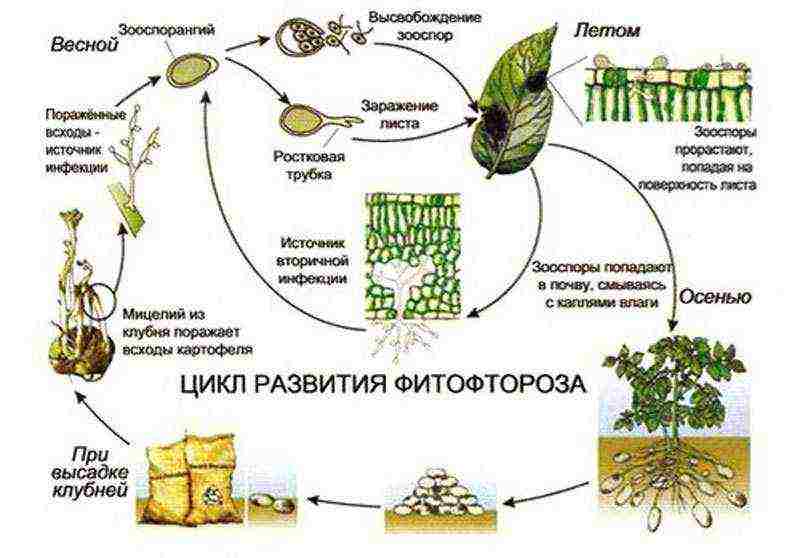
The "helper" for the development of this dangerous disease is excessive dampness in the room and in the pots, therefore it is necessary to water regularly and dosed - that is, follow all instructions with precision and without fanaticism.
Late blight can be recognized by the burgundy specks on the leaves, which gradually increase in size and merge into one large spot.

Having discovered the disease, it is necessary to immediately start treatment, spraying the bushes with a mixture of slaked lime and copper sulfate, prepared in the following proportions: dilute 10 g of copper sulfate in 900 ml of water, and 20 g of slaked lime in 100 ml of liquid.
Mix the prepared solutions, pouring the lime mixture into the vitriol composition with continuous stirring. It is necessary to spray with a fresh solution prepared immediately before processing, since after a day the mixture becomes unusable.
Fruits (even green) from infected bushes must be removed immediately. They must be immersed in hot water for 2 minutes, then removed, dried and put in a dark place for ripening.
Pay attention to this material - Growing tomatoes in a greenhouse and open field.
In order to prevent late blight, you need to treat a tomato bush with tincture of garlic and potassium permanganate: for 3 liters of water, 0.5 g of a loose component and 0.5 g of a vegetable. Do this every 1-2 weeks.
Features and caveats
Pots with tomato seedlings and mature shrubs should be turned once a day. This must be done due to the peculiarity - the stems begin to bend towards the sun.
You will be interested in this article - Raspberries: planting and care in the open field.
But direct sunlight is best avoided, otherwise the leaves may get sunburn. If there is too much sun, it is better to “tint” the windows with sheets of white paper.
Do not pluck unripe tomatoes from the bush. Let them ripen in the sun, then they will be fragrant and juicy. Also, you should not plant two sprouts in one pot - they will only interfere with each other and will not give a full harvest, and, possibly, will die. When the plant has enough nourishment, warmth and light, then it generously endows with a rich harvest.
Growing tomatoes on a windowsill in winter is very easy. Fresh juicy tomatoes will be not only a table decoration in winter, but also a vitamin supplement for your body.
Like the article ? Show it to your friends:
 Who among us does not dream of fresh vegetables that can be eaten not only in season? Why go to the supermarket in winter for imported tomatoes that don't even smell like them when you can grow natural tomatoes on the windowsill ?! By moving indoor flowers and freeing up space for several pots, fragrant and tasty tomatoes are easy to get even at home. How to do it correctly, in order to pamper your loved ones with vitamins all year round, will be prompted by a small selection of practical tips and recommendations, which we propose to familiarize yourself with today.
Who among us does not dream of fresh vegetables that can be eaten not only in season? Why go to the supermarket in winter for imported tomatoes that don't even smell like them when you can grow natural tomatoes on the windowsill ?! By moving indoor flowers and freeing up space for several pots, fragrant and tasty tomatoes are easy to get even at home. How to do it correctly, in order to pamper your loved ones with vitamins all year round, will be prompted by a small selection of practical tips and recommendations, which we propose to familiarize yourself with today.
Seed sowing time
The timing of when to start sowing tomato seeds for window sill cultivation does not have such restrictions as in the case of obtaining seedlings for open ground. It all depends on the period for which fruiting is planned: whether it will be a year-round "exploitation", or the maturation of the crop in particular in winter.
In order to have fresh vegetables throughout the year, regardless of the weather, seeds can be planted in 4 passes: autumn sowing in October and November will provide a winter harvest, and planting in February and March will guarantee fruit in the summer.
Preparation of planting material
 Potted tomatoes are grown in the same way as garden crops - through seedlings. You can use your own seeds, collected with your own hands from homemade tomatoes, or you can buy them in the store. However, regardless of origin, all seeds must first be prepared for sowing. For this:
Potted tomatoes are grown in the same way as garden crops - through seedlings. You can use your own seeds, collected with your own hands from homemade tomatoes, or you can buy them in the store. However, regardless of origin, all seeds must first be prepared for sowing. For this:
- Sort out hollow seeds by soaking everything in salted water (those that come up are not suitable for seedlings).
- Disinfect by leaving for half an hour in a solution of potassium permanganate.
To speed up the germination of seeds, they can be put in a cloth bag, well moistened and left on a platter for several days so that the seeds swell.
Soil selection
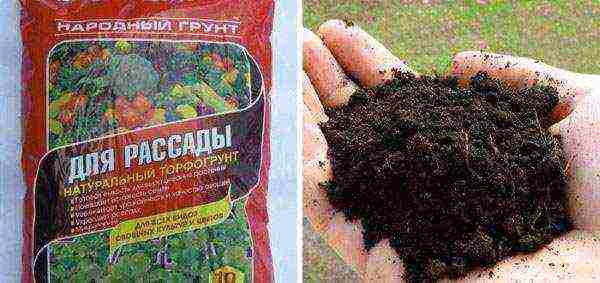 Particular attention should be paid to the substrate for growing tomatoes on the windowsill. It should be loose, nutritious and neutral in acidity. The easiest way is to contact the same store where the seeds were bought and purchase ready-made special soil mixtures for tomato seedlings.This will be especially important during winter sowing, in addition, the store land already contains all the necessary nutrients, and there is no need to add additional components.
Particular attention should be paid to the substrate for growing tomatoes on the windowsill. It should be loose, nutritious and neutral in acidity. The easiest way is to contact the same store where the seeds were bought and purchase ready-made special soil mixtures for tomato seedlings.This will be especially important during winter sowing, in addition, the store land already contains all the necessary nutrients, and there is no need to add additional components.
If there is a desire and opportunity, you can prepare the soil for growing a tomato on a windowsill yourself by choosing one of the proposed mixture options, namely:
- 1 share of sand and 2 shares of garden land;
- humus, peat and sod land in equal shares;
- 1 share of vermiculite, as well as 4 shares of sod land and compost.
The soil from the garden or vegetable garden must be disinfected before use by pouring it with boiling water or igniting it in the oven.
Sowing seeds and creating conditions for seedlings
 For growing tomato seedlings, you can use both a common container and individual cassettes, cups or peat tablets. In the first case, fill a shallow container with nutritious soil and moisten it well. Seeds should be laid out at some distance from each other (1-2 cm), deepening by no more than 2 cm, otherwise they will germinate for a long time. Then sprinkle with a thin layer of soil and tamp lightly.
For growing tomato seedlings, you can use both a common container and individual cassettes, cups or peat tablets. In the first case, fill a shallow container with nutritious soil and moisten it well. Seeds should be laid out at some distance from each other (1-2 cm), deepening by no more than 2 cm, otherwise they will germinate for a long time. Then sprinkle with a thin layer of soil and tamp lightly.
Seeds should germinate in a greenhouse, that is, the container must be covered with a lid or foil and placed on a bright window. Periodically ventilate the greenhouse or make several small holes in the film to avoid the accumulation of condensate. Optimal temperature conditions for seedlings at this stage of growth are from 22 to 24 degrees Celsius during the day and below 20 degrees at night.
 Caring for seedlings of indoor tomatoes consists in the following activities:
Caring for seedlings of indoor tomatoes consists in the following activities:
- airing;
- removing the cover after seed germination;
- regular watering;
- thinning out too dense crops;
- additional lighting with special lamps on cloudy days and shading from direct rays on sunny days (the length of daylight hours should be at least 13 hours);
- feeding with a weak solution of the mineral complex after the formation of 2 leaves (about 20 days after sowing).
Strong grown seedlings can be dived into pots, having previously laid a drainage layer on the bottom. The choice of containers depends on the specific variety:
- for dwarf tomatoes, a volume of 2 liters is enough;
- for medium-sized plants, 4-liter flowerpots are suitable;
- for ampelous varieties of tomatoes, pots with a volume of 5 liters are needed.
Further care for potted tomatoes
 In order for the tomatoes on the windowsill to develop well and set fruits, they need to provide good lighting by placing the pots on the southern windowsills. Every two days, the flowerpots must be turned so that the bushes do not grow one-sided, and if the sun is not enough, they must be illuminated.
In order for the tomatoes on the windowsill to develop well and set fruits, they need to provide good lighting by placing the pots on the southern windowsills. Every two days, the flowerpots must be turned so that the bushes do not grow one-sided, and if the sun is not enough, they must be illuminated.
It is also important to observe the watering regime, moistening the soil twice a week. The soil must not completely dry out, otherwise the ovary and fruits will crumble, but waterlogging also threatens with putrefactive diseases. After transplanting to a permanent place, you can start feeding the bushes after 20 days - during this time they adapt. It is enough to apply 3 times complex mineral fertilizers within a month, otherwise there is a risk that tomatoes will go into the growth of deciduous mass, which will entail a decrease in yield and crushing of fruits.
It is necessary to apply fertilizers on wet soil, preferably the next day after watering.
Dwarf tomato varieties do not need pinching and garter, but in higher species, a support should be installed and a bush should be formed into one or two stems, and stepchildren should be plucked out.
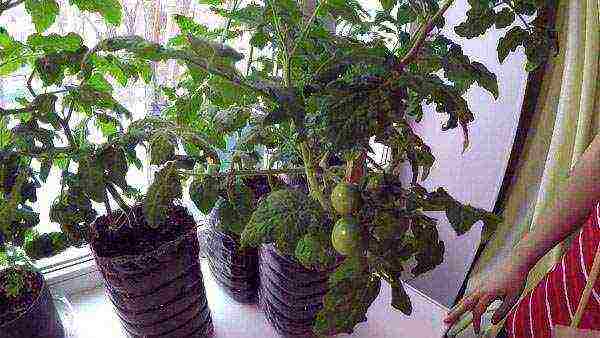 There are some more tricks that will increase the yield of tomatoes, namely:
There are some more tricks that will increase the yield of tomatoes, namely:
- when the bushes are blooming, you need to lightly shake the plants several times - this contributes to better pollination and, accordingly, will affect the amount of the crop;
- if a lot of ovary has formed, no more than 6 brushes should be left on each stem, having poured out the rest - this way you can get fewer tomatoes, but they will be larger;
- in varieties that ripen unevenly, it is better to harvest at the half-ripeness stage - then the bush will have more strength for the tomatoes remaining on the branches, and the plucked vegetables will quickly reach if they are laid out next to the pot on the windowsill.
Protecting tomatoes from disease
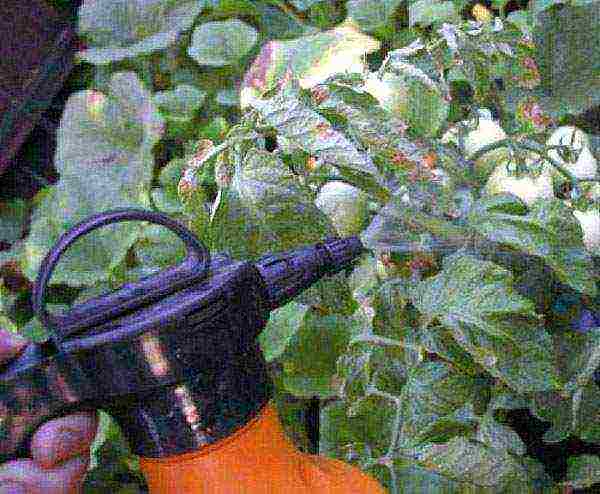 Another point worth paying attention to is the protection of tomatoes in pots from diseases, because even indoor conditions cannot guarantee their complete absence. One of the main enemies of nightshade is late blight. In order to prevent its manifestation, it is important not to fill the bushes and drain the water from the sump. The fungus also does not tolerate fresh air, so it is necessary to ventilate the room more often. As a preventive measure, you can spray the plants with a home remedy prepared from the following components:
Another point worth paying attention to is the protection of tomatoes in pots from diseases, because even indoor conditions cannot guarantee their complete absence. One of the main enemies of nightshade is late blight. In order to prevent its manifestation, it is important not to fill the bushes and drain the water from the sump. The fungus also does not tolerate fresh air, so it is necessary to ventilate the room more often. As a preventive measure, you can spray the plants with a home remedy prepared from the following components:
- 3 liters of water;
- 100 g garlic (minced);
- 1 g of dry crystals of potassium permanganate.
Indoor tomato varieties
When choosing a tomato variety for growing on a windowsill, it is worth giving preference to undersized, early ripening and fruitful species due to the limited space. They will not take up much space and at the same time will delight you with delicious fruits in early spring. Some of the most popular varieties are the following tomatoes:
- Balcony miracle. The height of a dense, even bush is no more than 60 cm. Small, round, bright red and sweet tomatoes ripen 90 days after sowing. The mass of one tomato is not more than 60 g. From one such dwarf, you can take up to 2 kg of fruits.

- Oak. The variety is not hybrid, early ripening, slightly branched, with a bush height of 40 to 60 cm. Rounded tomatoes weighing up to 100 g ripen at the same time, the pulp is fleshy, with a slight sourness. It requires artificial pollination in indoor cultivation, but it has a high resistance to late blight.

- Ruby Ed. The variety was created specifically for growing on windowsills, balconies and terraces. The bushes are compact, up to 50 cm in height. Small fruits weighing from 20 to 50 g have a sweet taste and rich red color.

- White filling. Bushes up to 70 cm in height grow equally well both in the open field and in a pot. The fruits ripen in 85 days, they are large enough (up to 130 g), rounded, red in color with a slight white tint. The pulp is juicy, with sourness, the skin is dense.

- Little Red Riding Hood. High-yielding variety up to 70 cm high with thick stems. Red-orange fruits weigh 70 g, the pulp is juicy, sweet and sour.
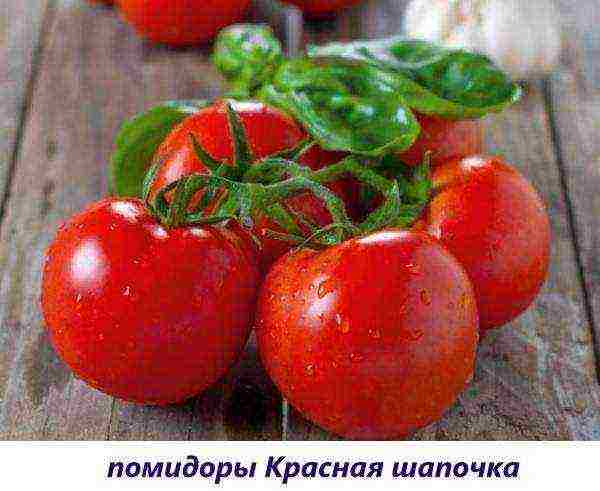
- Leopold. An ultra-ripe variety with a height of 70 cm. Fruits are dull red, weighing about 100 g.
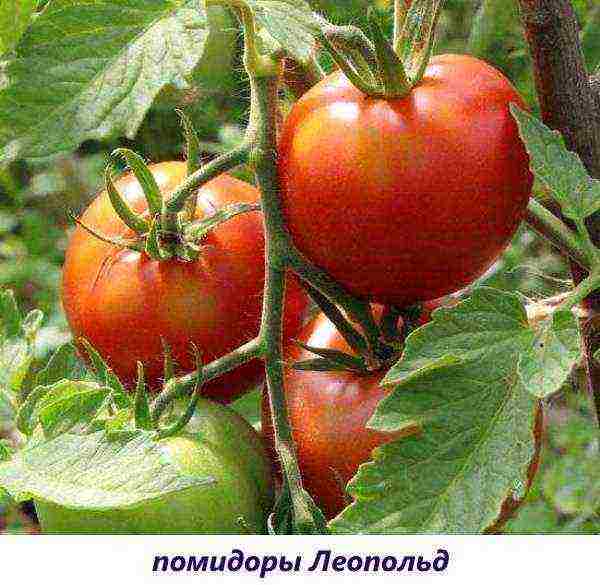
And in order to have fresh vegetables not only in spring, but also until the New Year, you can plant taller (up to 1 m in height) hybrid varieties of cherry tomatoes. On the windowsill, they will take up more space and require shaping and garters, but they will bear fruit before winter.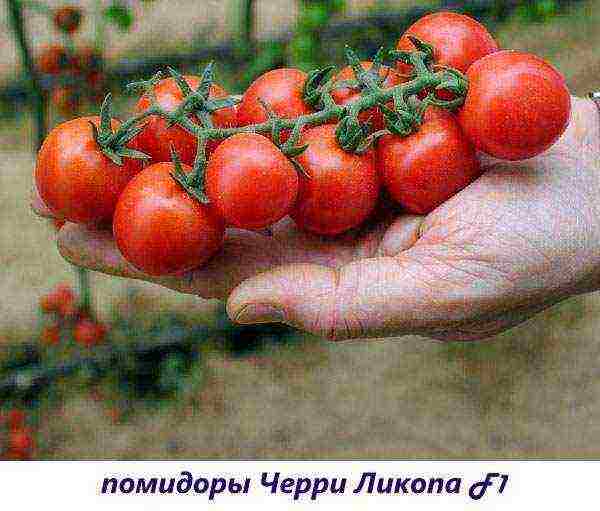
Some of the new, but already popular hybrids are such cherry varieties: Ira F1, Liza F1, Maxik F1, Likopa F1. Small but very tasty red or yellow tomatoes grow in whole clusters and ripen quickly.
For the summer period, it is better to take cherry pots to the street or to the balcony, not forgetting to take them to the house with a cold snap.
Growing a tomato on a windowsill is a fun activity that will not only help you while away the long winter days, but also provide your diet with vitamins. Plant and eat for health!
Video recommendations for growing tomatoes on a windowsill

Foreword
We grow tomatoes right on the windowsill - how can home-grown tomatoes for your table taste very different from the strange-looking and tasteless tomatoes sold in stores in winter. They are also very beautiful.
Tomatoes in winter, grown, ripened in their own garden, albeit on the windowsill, this is where the special taste and joy are. If your balcony is insulated, then the tomatoes on the balcony will be no worse than on the windowsill.
Which varieties to choose
Now they sell a lot of different varieties. Which one to choose?
To grow tomatoes on a windowsill, it is best to choose seeds of low varieties. Their fruits, most often, are not very large or small. This is exactly what we need as they do not require a lot of land for planting.
These varieties are Winter, Cherry, Yamal, Mini, Japanese dwarf, Bullfinch, Snowdrop, Chinese indoor, Balcony charm, Polar early ripening and many other varieties.
To grow tomatoes on the balcony, if it is insulated, you can choose taller and larger-fruited varieties. And care and everything else are no different from growing them on a windowsill.
What conditions are required for growing
Indoor tomatoes grow well if the conditions are met. They don't like waterlogging. They need to be watered very carefully, otherwise, they can get sick with a "black leg" or rot and die.
Tomatoes come from warm regions, they are born "Americans", so they are thermophilic and need a long sunny day. In order to provide them with this, it is necessary to keep the seedlings on the windows on the south side of the house, and on the north it is excluded.
- On short winter days, seedlings need to artificially increase daylight hours, turn on additional lighting. These can be fluorescent lamps, energy-saving lamps, or ordinary, sufficiently bright, lighting. The length of daylight hours should be at least 12 hours.
- It is permissible to lower the temperature in the room to 15-16 ° С at night, but during the day it should be at least 25-26 ° С. If the room is very hot, then it is necessary to regularly ventilate, the tomatoes are not afraid of drafts.
- The addition of an excessive amount of organic fertilizers will cause a strong growth of the green mass, and few fruits will be tied, they will be small.
Step-by-step instructions for growing a tomato
To grow indoor tomatoes, we first grow seedlings by purchasing seeds of the desired variety.
- We start by germinating these seeds. Seeds must be processed for the prevention of late blight. This is done by soaking the seeds in a slightly pink solution of potassium permanganate for 20-30 minutes.
- Preparing the land for sowing. This requires peat pots or plastic cups, at least 200 ml. We fill them with a purchased special soil mixture or make (if we have our own site) the mixture ourselves: 5 parts of soil + 5 hours of humus + 2 hours of sand, you can add a little peat. For a 10 liter bucket of the mixture, add 1 matchbox of urea + 1 box of potassium sulfate, a small handful of wood ash. Mix all this well and sprinkle it on the prepared container.
- Sow treated seeds. We moisten the prepared soil with a small amount of water and in shallow, up to 1 cm, lay out the dimples in 2-3 seeds, cover with earth. So that the earth does not dry out, cover the containers with seeds with glass or film until the sprouts sprout. We put it in a warm, but not hot, place. Then it remains to wait for the shoots. If necessary, sometimes you need to moisten the soil a little to make it easier for the seeds to emerge.
- After the shoots appear, we remove the film, transfer the pots to the window, and make sure that the shoots are light and warm. We regularly water the tomatoes on the windowsill, but little by little, we carefully monitor that there is no excess moisture in the ground.
- After the appearance of two real leaves, we make a pick, i.e. we plant the strongest sprouts in a separate bowl, where they will grow further. These dishes should be, significantly, large in size, its volume should correspond to approximately 7-10 liter bucket.
- Once every 10 days, we feed the seedlings with ready-made mineral and organic fertilizers. How to breed and feed is usually written on the package. Do not forget to loosen the soil around the trunk, but very carefully, trying not to damage the roots.
- As necessary, we tie the tomatoes to pegs, which we stick into the ground next to the trunk.
- Stealing. During the period of plant growth, additional stalks appear in the leaf axils - these are stepsons.They need to be removed, as they will take food from the fruit. You can leave 1 first stepchild to form the second stem of the plant.
- When the fruits have already set, we leave 4-5 brushes on the trunk, the rest are removed together with the top of the stem and other inflorescences so that they do not interfere with the growth and ripening of the set fruits. Do not forget to remove dried leaves, including the lowest ones, which interfere with watering at the root. Tomatoes are self-pollinating plants, but they are also advised to help pollinate. To do this, you just need to shake the flowering plant slightly or brush it over the flowers with a soft brush. We do this very carefully. Tomatoes can get sick without proper care. With excessive soil moisture, they are threatened with fungal diseases, such as: mold on the leaves, rot on the stem or late blight - black spots on the leaves.
- To prevent late blight, tomatoes (plants) are treated with infusion of garlic and potassium permanganate, consisting of ½ tbsp. garlic + 1/2 gram of potassium permanganate, diluted in three liters of water. You can periodically spray with a solution of phytosporin.
- Fruits that are poured and starting to turn pink must be removed and put to ripen on a window or in a cardboard box. They will no longer take nutrients from the still growing tomatoes.
Growing tomatoes on a windowsill is not a very difficult task, but in order to get a good result, you need to make an effort, like any other business. Plants must be grown with love and diligence, then they will be large and tasty.
